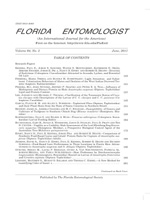Larinus minutus Gyllenhal (Coleoptera: Curculionidae) is a univoltine weevil that feeds on the seeds of spotted and diffuse knapweeds Centaurea stoebe ssp. micranthos (Gugler) Hayek and C. diffusa Lamarck. After emerging from overwintering sites in the leaf litter, adult weevils begin feeding on the vegetative portions of the plants. Adults, however, prefer to feed on flowers when they are available and development of beetle ovaries is dependent upon flower feeding (Groppe 1990). Females oviposit on newly opened flower heads (capitula). Two or 3 eggs can occur in each flower head, but only 1 larva usually develops in smaller capitula. Multiple larvae can survive in large spotted knapweed capitula (Groppe 1990). Under laboratory conditions (25°C), eggs hatch in 3-4 d (Groppe 1990). Larval development takes approximately 4 weeks and larvae go through 3 instars. Larvae feed on knapweed seeds and pupate in the capitula, making a cocoon out of the seed head material (Kashefi & Sobhian 1998). Larvae can destroy up to 100% of the seeds in a capitulum (Kashefi & Sobhian 1998). In the Western United States, adult weevils emerge in late Sep and feed on plants until winter, when the adults overwinter in leaf litter and emerge in the following Jun (Jordan 1995).
Larinus minutus was first released into the United States in 1991 with collections from Greece and Romania (Story 2002). Although 12 other natural enemy species were introduced into the Western United States and Canada to control spotted and diffuse knapweeds, only recently has adequate suppression of some populations been seen (Myers 2004; Smith 2004). Myers (2007) suggested that knapweed populations did not significantly decline until the establishment of L. minutus. Populations of L. minutus have been established in Washington, Wyoming, Oregon, Montana, Minnesota, Colorado, and Indiana (Lang et al. 1996; Story 2002).
No natural enemies of spotted knapweed have been released in Arkansas until the inception of this study. However, we found Urophora quadrifasciata (Meigen) (Diptera: Tephritidae) established throughout the range of spotted knapweed in the state in a survey in 2006 for knapweed natural enemies. This seedhead galling fly was introduced from Russia into Canada in 1980 and has since been redistributed or spread on its own to several states in the northeastern and northwestern United States (Story 2002). Duguma (2008) found that U. quadrifasciata reduced the number of seeds produced by spotted knapweed by 44% late in the season (Aug), at a time when plants are more environmentally stressed. However, the fly did not significantly reduce the number of seeds produced earlier in the season, a time when knapweed is most robust (Duguma 2008). Thus, it is likely that U. quadrifasciata alone will not significantly suppress knapweed populations in Arkansas, or stop its spread further into the southern United States.
To increase the level of control beyond that provided by U. quadrifasciata, we have introduced L. minutus in Arkansas. Collections of L. minutus were made from diffuse knapweed infestations in Colorado Springs, CO, for the Arkansas releases. A total of 8 releases were made during 2008 and 2009 (Fig. 1). Two releases were made in 2008 with 400 weevils released at the University of Arkansas Agriculture Experiment Station Farm, and 300 weevils released approximately 5 km south of the station. After the releases, sites were visually surveyed for surviving weevils each week. Weevils were observed for the remainder of the growing season in 2008. Six additional releases were made in 2009 in Washington County, Arkansas, with 600 to 700 weevils per release. Release sites in 2009 were of sufficient distance away from the release sites in 2008 that we believe the weevils had not spread to the new release sites. After releases in 2009, all sites were visually surveyed for adult weevils for the remainder of the growing season in 2009. Larinus minutus were found at all release sites (2008 and 2009) except one—the 2008- site just south of the University of Arkansas Agriculture Experiment Station.
Fig. 1.
Locations of releases of Larinus minutus in Washington County, Arkansas during 2008 and 2009.

Beginning in mid-Apr 2010, emerging adult weevils were collected weekly by sweep-netting at all Arkansas release sites, once plants had bolted, but before flowers were present. Larinus minutus were first found on May 5, 2010. Weekly sweeps yielded L. minutus at each of the 2008- and 2009-release sites, including the 2008-site at which no weevils were found during 2009. We believe that low population levels the first year after release prohibited us from collecting weevils at the south Fayetteville site. Finding weevils at all sites demonstrated establishment at the 2008-release sites and successful overwintering of adults at the 2009-release sites. Thus, L. minutus joins U. quadrifasciata as an established natural enemy of spotted knapweed in northern Arkansas.
Additional releases in northern Arkansas of ∼17,000 L. minutus were made in 2010 with weevils collected from Colorado Springs, CO.
We thank Jerry Michels and his crew from Texas A&M AgriLife for help in locating and collecting weevils in Colorado.
SUMMARY
Larinus minutus, a biological control agent of spotted knapweed, has been established at 2 sites in Washington County, Arkansas. The weevils were collected in Colorado and introduced into Arkansas at 2 sites in 2008 and 6 additional site in 2009. No L. minutus weevil was recorded in Arkansas prior to these releases.





